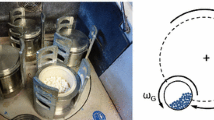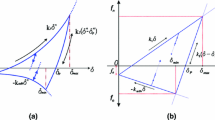Abstract.
The fundamentals of cohesive powder consolidation and flow behaviour are explained to combine reasonably particle and continuum mechanics. The influence of elastic-plastic repulsion and, consequently, stressing pre-history dependent adhesion is demonstrated by the new model “stiff particles with soft contacts” and the contact force equilibrium. With this as the physical basis, incipient powder consolidation, yield and cohesive steady-state flow are explained. These models are used to evaluate shear cell test results as constitutive functions for computer aided apparatus design for reliable flow.
Similar content being viewed by others
References
A. W. Jenike, Storage and flow of solids, Engng. Exp. Stat. Bull. No. 123, (Univ. Utah, 1964)
J. Schwedes & D. Schulze, Lagern von Schüttgütern, In: H. Schubert (Ed.), Handbuch der Mechanischen Verfahrenstechnik, (Whiley-VCH, Weinheim, 2003), p. 1137–1253
O. Molerus, Theory of yield of cohesive powders, Powder Technol. 12 (1975), p. 259–275
O. Molerus, Effect of interparticle cohesive forces on the flow behaviour of powders, Powder Technol. 20 (1978), p. 161–175
J. Tomas, Untersuchungen zum Fließverhalten von feuchten und leichtlöslichen Schüttgütern (investigation of the flow behaviour of moist and soluble bulk solids, Ph.D. Theses), Freiberger Forschungshefte A 677 (1983), p. 1–133
J. Tomas, Modellierung des Fließverhaltens von Schütt- gütern auf der Grundlage der Wechselwirkungskräfte zwischen den Partikeln und Anwendung bei der Auslegung von Bunkeranlagen (modelling of the flow behaviour of bulk solids on basis of the particle interaction forces and application at bunker plant design, Sc.D. Theses), (Habilitation, Bergakademie Freiberg, 1991)
J. Tomas, Assessment of mechanical properties of cohesive particulate solids – part 1: particle contact constitutive model, Particulate Sci. & Technol. 19 (2001), p. 95–110
J. Tomas, Assessment of mechanical properties of cohesive particulate solids - part 2: powder flow criteria, Particulate Sci. & Technol. 19 (2001), p. 111–129
J. Tomas, Zur Mechanik trockener kohäsiver Schüttgüter, Schüttgut 8 (2002), p. 522–537
J. Tomas, The mechanics of dry, cohesive powders, powder handling & processing 15 (2003), p. 296–314
J. Tomas, Mechanics of Nanoparticle Adhesion – a Continuum Approach, In: K.L. Mittal (Ed.), Particles on Surfaces 8: Detection, Adhesion and Removal, (VSP Utrecht 2003) p. 183–229
J. Tomas, Product Design of Cohesive Powders – Mechanical Properties, Compression and Flow Behaviours, Chem. Engng & Technol. 27 (2004), p. 607–618
J. N. Israelachvili, Intermolecular and surface forces, (Academic Press, London, 1992)
S. Antoniuk, J. Tomas, S. Heinrich & L. Mörl, Bruchprozesse bei der Druckbeanspruchung von Granulaten, Chem.- Ing.- Technik 76 (2004), p. 249–253
M. Medhe, B. Pitchumani & J. Tomas, Flow characterisation of fine powders using material characteristic parameters, J. Advanced Powder Technol. (2004) in press
Th. Kollmann & J. Tomas, Vibrational Flow of Cohesive Powders, In: A. Levy & H. Kalman (Eds.), Handbook of Conveying and Handling of Particulate Solids, (Elsevier, Amsterdam, 2001), p. 45–56
A. Haack & J. Tomas, Untersuchungen zum Dämpfungsverhalten hochdisperser kohäsiver Pulver, Chem.- Ing.- Technik 75 (2003), p. 1646–1649
B. Reichmann & J. Tomas, Expression behaviour of fine particle suspensions and the consolidated cake strength, Powder Technol. 121 (2001), p. 182–189
T. Mladenchev & J. Tomas, Flow properties of compressed fine filter cakes, Proc. Intern. Conf. Filtech Europa, Vol. L, Düsseldorf (2003), p. 497–505
L. Grossmann, J. Tomas & B. Czöke, Compressibility and flow properties of a cohesive limestone powder in a medium pressure range, Granular Matter 6 (2004), 103–110
R. Tykhoniuk, S. Luding & J. Tomas, Simulation der Scherdynamik kohäsiver Pulver, Chem.- Ing.- Technik 76 (2004), p. 59–62
S. Ecke & H.-J. Butt, friction between individual microcontacts, J. Colloid Interface Sci. 244 (2001), p. 432–435
S. Luding & H. J. Herrmann, Micro - macro transition for cohesive granular media, In: S. Diebels (Ed.), Zur Beschreibung komplexen Materialverhaltens, Institut für Mechanik, Stuttgart (2001) p. 121–134
Author information
Authors and Affiliations
Corresponding author
Additional information
The author would like to acknowledge his previous co-workers Dr. T. Gröger, Dr. Th. Kollmann, Dr. B. Reichmann and his present co-workers Dr. W. Hintz, Dr. S. Aman, and Dr. W. Schubert for providing relevant information and theoretical tips. The advises from H.-J. Butt [22] and S. Luding [23] with respect to the fundamentals of particle and powder mechanics were especially appreciated during the colaboration of the project “shear dynamics of cohesive, fine-disperse particle systems” of the joint research program “Behaviour of Granular Media” of German Research Association (DFG).
Rights and permissions
About this article
Cite this article
Tomas, J. Fundamentals of cohesive powder consolidation and flow. GM 6, 75–86 (2004). https://doi.org/10.1007/s10035-004-0167-9
Received:
Issue Date:
DOI: https://doi.org/10.1007/s10035-004-0167-9




